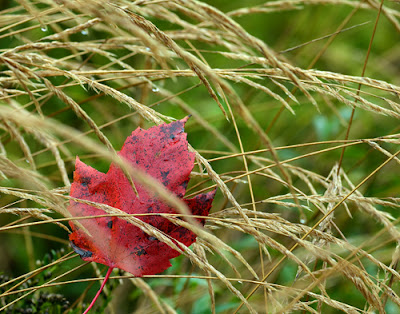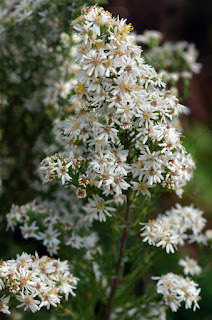One thing I've often said is that if a tree falls in the forest, and there is nobody around to hear it, it will fall across your trail. Not that it won't do this if you are around to hear it, but the point is, it will fall across your trail.
Or on to your best patch of Trailing Arbutus.
I happen to have three nice patches of Trailing Arbutus, Epigea repens, one of which is right beside one of my trails and is much larger and lusher than the others. Of course the dead Spruce fell right on it. It happened a few weeks ago in one of our wind storms. I inspected the situation, tsk'ed and walked around it.
So today I asked myself, 'self, what would you like to do with this fine cold windy afternoon' and the answer was, 'get that d... spruce off the Trailing Arbutus'. Right. I got out my old shabby green coat, which is warm and can't get any worse no matter what I do to it, my work gloves, my old saw and my trusty axe. I grabbed the biggest and reddest apple out of the fruit bowl, and set off for the woods. There were a few other things to clear along the way: a dead Balsam Fir top blown across the path, a large Cedar bough standing straight up as though it was a tree, and some Maple branches right at hair-snagging height. Once I got to the Arbutus patch I got right at it and hacked all the branches off the Spruce and moved them on to an existing brush pile. That left a long bare log lying on the ground, clear to view. A rather daunting view, given that it was about 15" across at the base, and me with no power saw. I'm scared of those things so I don't have one.Besides, it would be one more thing to store and maintain and anyway I hate power tools.
For no real reason, I jumped on the log near the top end. To my amazement, there was a loud cracking noise, and the log broke into three pieces! I was able to drag all three to the brush pile!
Then I stood quietly under the Maples nearby and enjoyed the yellow leaves planing down around me, mixed with some fat white snowflakes that were starting and finished my apple.
Sunday, October 18, 2015
Friday, October 9, 2015
October Observations
There's a lot to be said for October. Spring may be a fine sweet song, but in Autumn we can let go and find some peace. We've come through the frenzy of September, when we were assailed at every turn by chores not done, ideas not realized, plans not achieved, and now we are ready to let things be, do a little here and there, and just appreciate what the summer has left with us. Instead of thinking that maybe we can squeeze in a few hours of work tomorrow and get some particular mess tidied up, we are ready to say, well, I'll get to it next year.
The grasses on the Sand Hill have not been cut down. I'll just have to do them in the Spring. Meanwhile the waving seed heads, including one on the Miscanthus which isn't supposed to set seed, look thrilling sprinkled with raindrops and the occasional red Maple leaf.
Along the Marsh edge the Cinnamon and Interrupted Ferns have turned various shades of yellow and, well, cinnamon.
There are a couple of Royal Ferns which have appeared, tucked in among the Cinnamons, which I really should move. They were very small last year but have gotten a good bit bigger this year. The beavers chewed down a couple of small Maples nearby (you can see part of one trunk lying here) and the added sunlight has given the ferns a real boost. I'm trying to see the good side of beavers, and the way they keep the marsh edge open is probably good. I'll have to move the Royal Ferns, though. Next year.
A few things are very late bloomers. Sometimes it is because they are in too much shade, or in a spot too dry for them, but sometimes they are simply things that bloom late. A native Aster that is always late is Heath Aster, Symphyotrichum ericoides. I've been wanting one ever since I saw a plant at the Fletcher Wildlife Garden. It was huge - about 3' tall and 6' across - and an absolute magnet for bees and wasps. I kept looking around the Valley, expecting to see some, but I didn't until a few weeks ago when I happened to be driving to Kingston. Near Carleton Place I found a small field, really a meadow, with many Heath Asters. Several were growing right up near the road... and there were ripe seeds on many of them.
Heath Aster is easily recognized, unlike the other Asters, due to its thickly filled flowering wands, tiny florets, and many very small leaves up and down the stems.
I've got seeds in pots, ready for next year.
Something else that often blooms late is Japanese Anemones. All the ones available at nurseries are cultivars, mostly of Anemone japonica. Many were developed in Europe where the summers are longer and warmer, and when they emigrate to Canada they have a hard time blooming before it gets too cold. So we end up with Anemones in October. The basic A. japonica blooms much earlier, July, but many of the varieties seem to be later. There are white ones, pale pink ones, pink ones, single ones and double ones. It pays to try a few kinds and to move them around until you get what you want.
But be warned! Japanese Anemones always remind me of those bold-eyed boys that foolish girls like, dangerous and exciting, but impossible to live with. These plants put down massive roots and can lay claim to entire gardens. Unless they are in a spot they don't care for... like the double white one I accidentally put under a Crabapple tree and which can't seem to get its feet under itself. Guess I'll move it. In the Spring.
Last but not least of the things I've been admiring today are a couple of the New England Aster varieties sold in nurseries. Again, they were developed in Europe, Germany in this case, and they bloom too late for us here. By the time 'Andenken an Alma Potsche' and this unamed dark purple one bloom, they are alone in the border.
I've already moved bits of Alma (as I call her) to better spots - one in front of the Yuccas on the hillside, and one to a sunnier spot, but I'll move the main plant next year as well. Maybe put it in front of some pale Japanese Anemones, and put the dark purple aster nearby. If they bloom together, they should be a nice spot of colour in the mainly yellow and orange of Autumn.
Next year.
The grasses on the Sand Hill have not been cut down. I'll just have to do them in the Spring. Meanwhile the waving seed heads, including one on the Miscanthus which isn't supposed to set seed, look thrilling sprinkled with raindrops and the occasional red Maple leaf.
Along the Marsh edge the Cinnamon and Interrupted Ferns have turned various shades of yellow and, well, cinnamon.
There are a couple of Royal Ferns which have appeared, tucked in among the Cinnamons, which I really should move. They were very small last year but have gotten a good bit bigger this year. The beavers chewed down a couple of small Maples nearby (you can see part of one trunk lying here) and the added sunlight has given the ferns a real boost. I'm trying to see the good side of beavers, and the way they keep the marsh edge open is probably good. I'll have to move the Royal Ferns, though. Next year.
A few things are very late bloomers. Sometimes it is because they are in too much shade, or in a spot too dry for them, but sometimes they are simply things that bloom late. A native Aster that is always late is Heath Aster, Symphyotrichum ericoides. I've been wanting one ever since I saw a plant at the Fletcher Wildlife Garden. It was huge - about 3' tall and 6' across - and an absolute magnet for bees and wasps. I kept looking around the Valley, expecting to see some, but I didn't until a few weeks ago when I happened to be driving to Kingston. Near Carleton Place I found a small field, really a meadow, with many Heath Asters. Several were growing right up near the road... and there were ripe seeds on many of them.
Heath Aster is easily recognized, unlike the other Asters, due to its thickly filled flowering wands, tiny florets, and many very small leaves up and down the stems.
I've got seeds in pots, ready for next year.
Something else that often blooms late is Japanese Anemones. All the ones available at nurseries are cultivars, mostly of Anemone japonica. Many were developed in Europe where the summers are longer and warmer, and when they emigrate to Canada they have a hard time blooming before it gets too cold. So we end up with Anemones in October. The basic A. japonica blooms much earlier, July, but many of the varieties seem to be later. There are white ones, pale pink ones, pink ones, single ones and double ones. It pays to try a few kinds and to move them around until you get what you want.
But be warned! Japanese Anemones always remind me of those bold-eyed boys that foolish girls like, dangerous and exciting, but impossible to live with. These plants put down massive roots and can lay claim to entire gardens. Unless they are in a spot they don't care for... like the double white one I accidentally put under a Crabapple tree and which can't seem to get its feet under itself. Guess I'll move it. In the Spring.
Last but not least of the things I've been admiring today are a couple of the New England Aster varieties sold in nurseries. Again, they were developed in Europe, Germany in this case, and they bloom too late for us here. By the time 'Andenken an Alma Potsche' and this unamed dark purple one bloom, they are alone in the border.
I've already moved bits of Alma (as I call her) to better spots - one in front of the Yuccas on the hillside, and one to a sunnier spot, but I'll move the main plant next year as well. Maybe put it in front of some pale Japanese Anemones, and put the dark purple aster nearby. If they bloom together, they should be a nice spot of colour in the mainly yellow and orange of Autumn.
Next year.
Subscribe to:
Comments (Atom)







